Following is from a report in Pioneer.
The State Government in the Department of Health and Family Welfare on Saturday asked the district authorities of Kalahandi, Kandhamal, Sundargarh and Dhenkanal to start preliminary work for construction of four General Nursing and Midwifery Training Schools in those districts at a cost of Rs 10 crore each.
Out of the required Rs 40 crore, the Central Government has agreed to release 85 per cent and the State would have to bear 15 per cent. …
Besides, the Government has also directed the departmental authorities in Nabarangpur, Boudh and Subarnpur to accelerate the process of completing the GNM Training School and two ANM Training Schools under construction in the districts, respectively. The Centre has released Rs 4.75 crore out of a total of Rs 17 crore. The State Government has also released Rs 1 crore while another Rs 3. 33 crore has been laid out in the current year towards the State’s share.
March 4th, 2012
Our first posting in this site was on November 28th, 2006. It is at https://www.orissalinks.com/archives/7. It was about a central university in KBK. We succeeded in our mission and a central university in KBK was announced in March 2008, and it has now been established in Koraput district.
Earlier this year (On May 22nd 2011) I wrote to the planning commission to establish a central agricultural university in Odisha as part of the 12th plan. Following are excerpts of my mail.
I propose that the 12th plan staring from 2012 include several Central Agricultural Universities in backward district clusters of India that have potential for agriculture.
Sirs and and Madams: One of the biggest achievement of the 11th plan was that the new institutions (16 central universities, 8 new IITs, 7 new IIMs, proposed 20 new IIITs, proposed 14 innovation universities) were located across India, in states ruled by UPA, in states not ruled by UPA, and so on. It was an inclusive distribution and less driven by political connections.
I request that similar distribution be made with respect to the institutions that are proposed for the 12th plan, starting with several central agricultural universities with various colleges (Agriculture, Horticulture, Veterinary, etc.).
The initial wave of creation of agricultural universities across India (in the 1960s) were an important factor in the initial Green revolution of India. However, as has been noted in the last two budgets (2010-11 and 2011-12) there is a need for another such revolution, especially taking into account factors such as (i) further mechanization (ii) urbanization (iii) looking east and (iv) developing backward and tribal areas.
In the 2010-11 budget speech ( http://indiabudget.nic.in/ub2010-11/bs/speecha.htm ) the Finance Minister had said the following:
44. The agriculture sector occupies centre-stage in our resolve to promote inclusive growth, enhance rural incomes and sustain food security. To spur the growth in this sector, the Government intends to follow a four-pronged strategy covering (a) agricultural production; (b) reduction in wastage of produce;
(c) credit support to farmers; and (d) a thrust to the food processing sector.
45. The first element of the strategy is to extend the green revolution to the eastern region of the country comprising Bihar, Chattisgarh, Jharkhand, Eastern UP, West Bengal and Orissa,…
In the 2011-12 budget speech ( http://indiabudget.nic.in/bspeecha.asp ) he said the following:
Bringing Green Revolution to Eastern Region
52. The Green Revolution in Eastern Region is waiting to happen. To realize the potential of the region, last year’s initiative will be continued in 2011-12 with a further allocation of `400 crore. The program would target the improvement in the rice based cropping system of Assam, West Bengal, Orissa, Bihar, Jharkhand, Eastern Uttar Pradesh and Chhattisgarh
.
Both speech say the green revolution needs to be extended to the eastern region. The allocation of a total of 400 crores to 7 states is miniscule for the purpose and does very little.
Hence, I request that this aspect of extending the green revolution to the eastern region be taken seriously and in the 12th plan Central Agricultural Universities be established in appropriate locations in these states and some of the other states of the country.
Somewhat of a start in this direction has been made via the allocation of 30 crores for a Central Agricultural University in Bundelkhand in the 2011-12 budget.
It was reported by the press that Mr. Rahul Gandhi lobbied for this.
I would like to thank him for his vision and initiative and humbly request the planning commission that they need to also think of the other backward areas of the country.
Taking all the above into account, it would be a win-win to include the establishment of several Central Agricultural Universities in the country located in backward districts with agriculture potential. The win-win aspects are:
(i) They will help higher education and GER, but will not stress the MHRD budget or its management. The majority of the funding could come from the Ministry of Agriculture with some required contributions from the state governments.
(ii) They will help bring in a new green revolution in some areas and extend the green revolution to the eastern region.
(iii) Since there have not been many new agricultural universities across the country, it will be comparatively easier to recruit faculty for these new institutions.
(iv) By locating them in the backward district clusters, they will bring Bharat and India closer.
I had sent copies of my mail to the MPs of Odisha as well as the Chief Minister’s officer. I talked to the secretary of agriculture Ranglal Jamunda by email at agrsec.or@nic.in as well as by phone and urged him that the Odisha government must push for a central agricultural university in Odisha, especially in the KBK regions (in particular, Kalahandi, as Kalahandi is known to be one of the rice bowl of Odisha; and Kalahandi was skipped over when deciding on the location of the central university in Koraput).
My emails and phone calls has had no visible impact on Odisha government, Odisha officials or Odisha MPs as so far I have not read any news regarding Odisha pursuing a central agricultural university. However, the news of the West Bengal government pursuing a central agricultural university came out after a few days of my writing to the planning commission. It is possible that may mail to the planning commission somehow got forwarded to the right people in West Bengal or it may just be a pure coincidence. Following is from a Telegraph article on 13th July 2011.
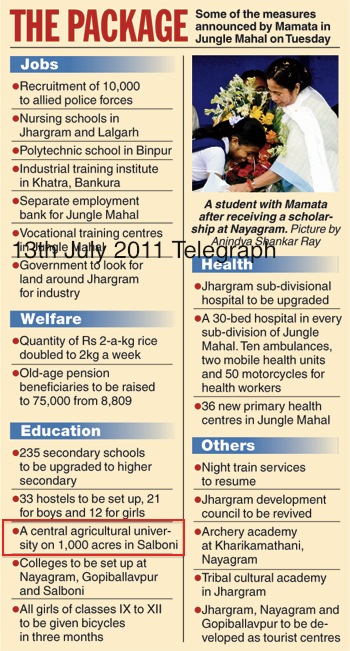
I think there is still time to pursue to get this included in the 12th plan. I request all readers to write to the Chief Minister’s office at cmo@ori.nic.in regarding this.
Sincerely,
Chitta Baral
November 29th, 2011
To get a clear picture on higher education moves by the state government (during the last 5 years) outside of the capital area (Khurda, Cuttack and Puri districts) we try to list the moves. Many fully centrally funded institutes are mentioned as the state contributes by free land and in making the location decision. (Note that Odisha has 30 districts.)
What has been done so far (including under construction):
- Central University of Orissa, Dist – Koraput
- Upgradation of UCE Burla to VSSUT, Dist – Sambalpur
- Private University status to Centurion, Dist – Gajapati
- Government Engieering College, Bhawanipatna, Dist – Kalahandi
- College of Agriculture, Bhawanipatna, Dist – Kalahandi
- WODC funds and free land for Private Medical College, Jaring, near Bhawanipatna, Dist – Kalahandi (significant part of the construction is complete)
- Pushed Vedanta to establish Vedanta Science College in Lanjigarh, Dist – Kalahandi
- Parla Maharaj Engineering College, Berhampur, Dist-Ganjam
- Special SUIIT institute as part of Sambalpur University, Dist – Sambalpur
- WODC funds for Hi-Tech Medical College, Rourkela, Dist – Sundergarh (under construction)
- Indian Institute of Handloom Technology, Baragarh
- College of Horticulture, Chipilima, Dist – Sambalpur
The districts involved above and the number of items for them are: Baragarh (1), Gajapati (1), Ganjam (1), Kalahandi (4), Koraput (1), Sambalpur (3), Sundergarh (1). If one takes the funding amount as the criteria then Koraput comes at the top.
Some of the announcements that are most likely to happen in 1-3 years as reported in the news:
- Pushed MCL to agree to make a medical college in Talcher
- Pushed NTPC to agree to make a medical college (location not announced)
- Pushed NTPC to agree to make a Power Institute (location not announced)
- Announced that all three medical colleges (includes Berhampur, Sambalpur) will be autonomous starting with the one in Sambalpur.
- Announced that Khallikote College Berhampur will be made to a university
- Proposed that one of the 20 IIIT should be in Berhampur.
- Pushing to upgrade FCI Balangir to an Institute of Hotel Management
- Grants to XIMB to open a campus in Balangir
- Grants to XIMB to open a campus in Sambalpur
- Support for a CIPET campus in Balasore
- Upgradation of GM College, Sambalpur to a university (announed by Higher Education Minister)
The districts involved in the above two lists and their number of items are: Angul (1), Balasore (1), Balangir (2), Baragarh (1), Gajapati (1), Ganjam (4), Kalahandi (4), Koraput (1), Sambalpur (6), Sundergarh (1).
The districts that are left out are: Bhadrak, Bouda, Deogarh, Dhenkanal, Jagatsinghpur, Jajpur, Jharsuguda, Kandhamala, Kendrapada, Keonjhar, Malkangiri, Mayurbhanj, Nabarangpur, Nayagarh, Nuapada, Rayagada and Sonepur.
Besides the above there have been reports about government willing to give grants to several private medical colleges in various places and the WODC has tried (but failed) to entice (through grants and free land) a private party to establish a medical college in Balangir.
Also, I think the government will implement some of the recommendations made by the higher education task force.
Please suggest missing items in the comments section. Any capital-bashing comments will be deleted as the purpose of this post is to get a clear picture of what is happenning and not happening in the higher education side outside of the capital districts of Khurda, Cuttack and Puri.
Again, this list is to get a clear picture of what has happened in the non-capital area districts so that one can make an informed decision if the government is biased towards some non-capital districts over other non-capital districts. (There is no argument that the bulk of the moves have been made favoring the capital area. So no discussion on that.)
In regards to my personal view on what the government ought to do, it is listed in details in the site http://orissa2020.org.
The above list should not be interpreted in isolation. For example, one should not conclude that Kalahandi got too much. It got several institutions because it started from very little and the education conscious people of Kalahandi have been rightly demanding for higher education institutions for a long time. But at the same token, arguing that Kalahandi has been neglected by this government with respect to higher education just goes against the facts above and I worry that the well-meaning people who are making such arguments may be harming their cause. I guess the argument comes from losing the central university to Koraput. But then every district other than Koraput (and the capital districts) can use that argument. [If there is interest I will explain more on my take on this in the comments section.]
As an analogy, in 2005 we could rightly argue that the central government neglected Odisha with respect to centrally funded higher education institutions. But if we now say that the UPA government neglected Odisha with respect to centrally funded higher education institutions, we will be laughed at, and our efforts will have negative impact. So we plan to use finer arguments and location specific arguments to push for central institutions in Odisha for the 12th plan.
Kalahandi people wanting more institutions in Kalahandi should think of other ways to make their case and irritating the state government and its bureaucrats with arguments that go against the facts (see list above) may help some politicians but has a higher potential to harm Kalahandi’s case than help its case.
March 29th, 2011
(Thanks to Kalahandia for the pointer.)
Following is from http://expressbuzz.com/states/orissa/medical-college-to-see-light-of-the-day/253254.html.
The last one year has rekindled hopes for Kalahandi waiting since long for a medical college as promised by the State Government. Sardar Raja Medical College at Jaring is expected to start functioning from 2012 academic year, the chief executive officer of the college Tarun Mishra announced at a press meet here.
The project got clearance from the State Government in 2004 after an MoU was signed with a private educational institute Salvam Educational and Charitable Trust, Tamil Nadu. The Revenue Department provided 25 acres at Jaring and Western Orissa Development Council released Rs10 crore for infrastructure development. Work soon picked up on the 300-bed hospital, college and hostel buildings.
However, the project suffered a setback with the chairman of the trust entangled in a legal battle in Tamil Nadu. The long court battle had raised doubts about the future of the project. Last year, the college also failed to get a nod from the Medical Council of India mostly due to lack of adequate number of doctors, staff and some basic infrastructure. This had led to resentment among the locals.
With the charges against the chairman of the trust dropped, the project witnessed some positive development this year.
Mishra said that the infrastructure as pointed out by MCI has been put in place. The Health and Family Welfare Department has already issued essentiality certificate and Sambalpur University given consent for affiliation. MCI permission has already been sought and the team is expected to be here soon. Pending works have been taken up on a war-footing to meet the MCI stipulations, he added.
The chairman of the Salvam Educational and Charitable Trust SA Raja, in a press release, said that the commitment for establishment of a medical college and super speciality hospital will be fulfilled and he thanked people for their cooperation for success of the project despite undue delay.
It would be interesting to see whether this one becomes operational first or the AIIMS-like institute in Bhubaneswar gets operational first. Looks like both are scheduled to take in students in 2012. The foundation stone of the AIIMS-like institution was laid in 2003, a year earlier than the medical college in Kalahandi.
March 4th, 2011
Following is an excerpt from a report in tathya.in.
Prof. Gopabandhu Behera and Dr. A. K. Nanda, who are also the Governing Body member of Vedanta Science College were also present.
Mr.C Joseph, in-charge of the Vedanta Science College, Nabakrushna Panda, Principal, Government Autonomous College, Bhawanipatna, S P Nanda, Principal, Government, Women’s College, Bhawanipatna, Sudershan Rath, Principal, Bisamcuttack College and Bharat Rath, Principal Rayagada Government College also graced the conference.
The objective of the conference was to make the people conscious about the value of science education at degree level as well as to discuss about the proposed Vedanta Science College at Lanjigarh.
Dr. Kumar, President and COO, VAL, said, “Vedanta Science College was a long pending demand of the people of Western Ordisha.
He said that Vedanta is committed to create a state of art Science College that will promote quality science education in Western Odisha.
Quality Science education can help in developing technical manpower for industrialization in the state, he added.
The proposed Vedanta Science College will start its academic session from 2011.
The institution will provide education in subjects of Physics, Chemistry, Botany, Mathematics, Zoology, and Environmental Science.
It should be noted that there are very few (could be zero) fully private (i.e., without depending on state grants) science colleges in Odisha. Even the government ones and private ones that depend on state grants do not have good infrastructure and do not have adequate quality faculty. The more well known private higher education institutions of the state focus on trade oriented disciplines like engineering, management, medicine, pharmacy, biotechnology etc. so that they can charge adequate amount of student tuition. This includes deemed universities like KIIT and SOA and the private state university Centurion. None have science programs at the Bachelors level.
So if the Vedanta Science college in Lanjigarh becomes a good quality science college, then it would be a big boon to Kalahandi and Rayagada districts and hopefully it will also encourage other private groups to establish similar colleges.
January 31st, 2011
Following is from a report in Pioneer.
Vedanta is going to open a science college at Lanjigarh in Kalahandi to spread higher education among tribals. The Vedanta Science College will commence classes from the academic year 2011-12.
The company has identified five acres of land at Lanjigarh for the purpose. The architectural design of the college has been completed and construction activity will begin soon. The bhoomi puja for construction of the building was performed last month.
“The science college will fill the gap of quality science education in western Odisha. Besides education, it will also improve the human development index and leadership quality among youth,” said Prof Gopabandhu Behera, retired Professor of Chemistry of the Sambalpur University.
Most towns in interior western Odisha mostly have arts and commerce colleges, where job opportunities for students passing out are limited. The proposed college is expected to address the need for quality science education in the district of Kalahandi and will make the youth qualified enough to get ample job opportunities.
The first batch of students will be admitted on merit basis, with preference to local students. In the first batch, the college will enroll 64 students. “Vedanta Science College will integrate teaching, learning, and research for a holistic development of the students,” said President and Chief Operating Officer of Vedanta Aluminium Ltd, Lanjigarh Dr Mukesh Kumar.
The college will impart graduate level studies in Physics, Chemistry, Mathematics, Zoology, Botany and Environment Science. The college will be managed by the DAV College Trust and Management Society, which is a premier education society and has already set up more than 100 colleges across the country. With the latest infrastructure, the college will provide facilities for sports, games and cultural facilities.
In Lanjigarh, the DAV College Trust and Management Society has set up an international school jointly with VAL which is giving access to quality English medium education to tribal students from Lanjigarh and around.
January 4th, 2011
Following is an excerpt from a report in Pioneer.
December 17, 2010 11:59:31 AM
BIKASH KHEMKA | BHAWANIPATNA
Spiritualism pervaded the air here with Art of Living Guru Sri Sri Ravishankar’s visit and didactic discourse on Wednesday evening at the college field here thronged by the people of both Kalahandi and adjacent districts.
The backdrop of the dais was catchy with the images of Maa Manikeswari Temple, Chhatar Yatra and the primitive tribal groups depicting the true aura of this tribal district.
In the morning hour, Ravishankar laid a foundation stone at nearby Dharmagarh for an agriculture university and air-dashed here by chopper at around 2.30 pm.
Following is an excerpt from a report in orissadiary.com.
The founder of Art of Living , Spiritual Guru HH Sri Sri Ravishankarji meets Chief Minister Naveen Patnaik in the Orissa Secretariat on Thursday and discussed with the Chief Minister regarding progress of proposed Sri Sri University at Narah Bidyadharpur.
In course of Discussion, Ravisankarji has proposed to set up an Agriculture University at Kalahandi. Ravisankarji also expressed that besides Agriculture, training will be imparted on Medicinal Plants.
This is wonderful news. Earlier it was reported in kalahandia that about 100 acres has been identified for the above mentioned university.
December 17th, 2010
Update: Odisha must push for a second campus of Indian School of Mines. See https://www.orissalinks.com/archives/6076 for the reasoning that can be used for this.
The twelfth five year plan starts from 2012. It is only two years away. The eleventh plan fetched us a NISER (Bhubaneswar), IIT (Bhubaneswar), Central University of Orissa (Koraput), and plans for an innovation university (Bhubaneswar) and a centrally funded IIIT (Berhampur). Since all of these are in their earlier stages and there were 5+1 IISER/NISERs, 8 new IITs, 16 new/upgraded central universities, plan for 14 innovation universities and plan for 20 IIITs across the country I do not think there will be new ones of them in the 12th plan.
However, there are other kinds of centrally funded institutes and universities that were not much covered in the 11th plan, but yet there were instances of them in some parts of the country. I think if we focus on them from now it is possible that we can influence the inclusion of their establishment across the country in the 12th plan with some locations in Odisha. It is important to push these ideas as pan-Indian ideas rather than Odisha specific. Within Odisha by focusing on "backward districts" we can achieve a good distribution.
Following are some pan-Indian ideas that come to mind.
- Several Central Agricultural Universities in backward areas of the country, including one in Kalahandi: Currently there is a Central Agricultural University HQed in Imphal. (http://www.cau.org.in/). I came across the news item in http://bundelkhand.in/portal/NEWS/Centre-clears-an-AIIMS-like-institute-for-Jhansi-Bundelkhand that says "the Union agriculture ministry had given the go-ahead to develop a central agriculture university in Jhansi". I think a good case can be made that instead of just Jhansi (in the backward Bundelkhand district) such universities should be made in several backward district clusters in India. In Odisha at one time Kalahandi was known as the Rice Bowl of Odisha. Also, with the central government’s role in harming the industrialization of Kalahandi they may be sympathetic to establish a CAU there.
- Several Central Institutions of Technology in backward areas of the country, including one in Balangir: Currently, a Central Institute of Technology exist in Kokrajhar, Assam. Similar ones exist in Longowal Punjab (SLIET), and one being made in Malda (GKCIET). These are all centrally funded institutions, have rural focus and are aimed at 3-tiers: workers, technicians and engineers. See https://www.orissalinks.com/orissagrowth/archives/3911 for some more details on these colleges. I think a good case can be made that such institutions be made across India in the various backward district clusters. In Odisha, Balangir may be suggested as the location as the third district cluster of the famed backward KBK region. With CUO in Koraput and and a CAU in Kalahandi, Balangir is the right place for a CIT.
- Upgradation of several engineering colleges to IIESTs, including the upgradation of VSSUT, Burla: Now that go ahead has been given to upgrade BESU (Bengal Engineering and Science University) to an IIEST (Indian Institute of Engineering, Science and Technology), this idea should be expanded to another dozen or so colleges across India. In Odisha, VSSUT is the one most suitable for this upgrade. In this regard one may note that as per the evaluation in http://www.npiu.nic.in/PDF/Govt-25-1.1.zip and http://www.npiu.nic.in/PDF/Govt-58-1.1.zip only two government colleges (one in Pondicherry (75) and one in Hubli (77)) in India have a higher score than VSSUT’s score of 73. Even among the colleges listed in http://www.npiu.nic.in/PDF/Govt-71-1.2.zip only BITS-Mesra (76), Sri Jayachamarajendra College of Engineering, Mysore (82), Institute of Chemical Technology, Mumbai (80) and NIT Surathkal (77) have a higher score than VSSUT’s 73. [I am not sure if the colleges in the last list were scored on the same parameters as VSSUT.]
- Several National Sports Institutions/Universities, including one HQed in Rourkela: Currently there are two such institutes: Lakshmibai National University of Physical Education (LNUPE), Gwalior and Netaji Subhash National Institute of Sports (NSNIS), Patiala. Recently, a proposal was received by GOI from the Ministry of Youth Affairs & Sports to convert Rajiv Gandhi National Institute for Youth Development, an institution deemed to be university, at Sriperumbudur into Rajiv Gandhi Central University/National Institute of Youth and Sports. I think a good case can be made that such institutions be made across India in districts and locations that are catchment areas for various sports. In Odisha Rourkela would be the right choice with a possible branch campus around Kendrapada (women’s soccer) and Jagatpur (Rowing).
- Additional branches of IGNTU (Indira Gandhi National Tribal University) including one in Kandhamala: Indira Gandhi National Tribal University is HQed in Amarkantak, MP. Its act mentions that the university will have branch campuses in various locations across India. The government of Odisha has proposed Kandhamala as the location of one such branch campus. This should be pushed and perhaps another campus may be proposed for the tribal areas cluster of Keonjhar and Mayurbhanj.
In addition we need to continue to push for a medical college and an engineering college as part of the Central University of Orissa, Koraput. The state government and the CUO Koraput authorities are already doing it.
December 15th, 2010
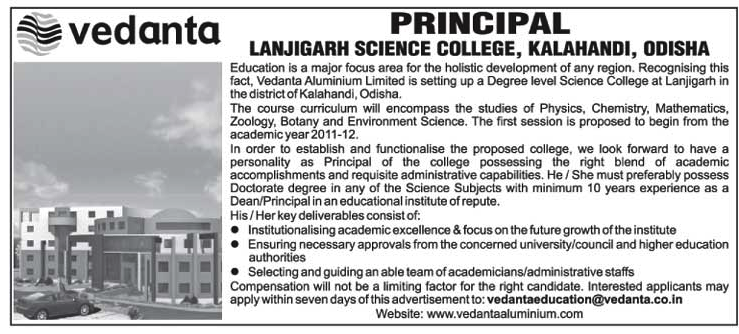
Although this may not become part of Vedanta University, such feeder and/or associated colleges in Vedanta Company’s operational areas will hopefully bring more goodwill to Vedanta University. This is a good start. More is needed though. Colleges that can take in mostly local students and produce graduates that can find jobs, such as Nursing and B.Ed Colleges in Kalahandi and Jharsuguda, would be appreciated.
December 4th, 2010
(Thanks to kalahandia.blogspot.com to initially attracting our attention to this.)
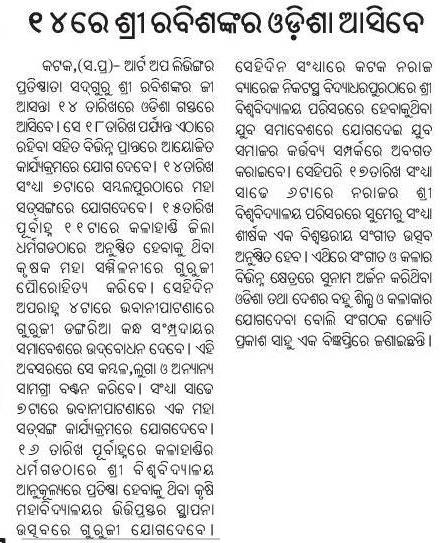
December 4th, 2010
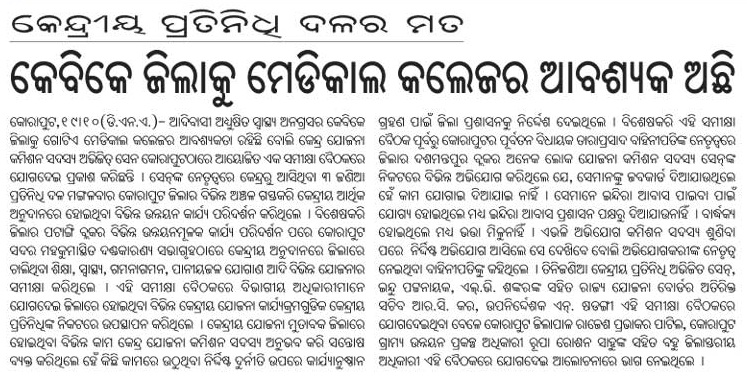
October 20th, 2010
Following is from a report in tathya.in.
Vedanta Aluminium will set up first ever science college at Lanjigarh of Kalahandi District in Orissa.
The full session will begin from the academic year 2011-12.
The college will impart graduate level studies in Physics, Chemistry, Mathematics, Zoology, Botany and Environment Science.
This will be funded by the Lanjigarh Project Area Development Foundation (LPADF) – the special purpose vehicle formed for as per the advice of the Supreme Court.
In the last Lanjigarh Project Area Development Foundation (LPADF) meeting, it has been decided to open a graduate science college at Lanjigarh to provide opportunities to large no of students of the block as well as nearby area like Muniguda, Ambodola and Biswanathpur area; as no such college is available within 50 KM radius of Lanjigarh.
The opening of the science college will fulfill the demand of local residents, who are demanding the science college for a long time.
Dr. Mukesh Kumar, Chief Operating Officer, Vedanta Aluminium Limited, Lanjigarh and Director of LPADF said, “It is the long due for the people of Lanjigarh.
… Vedanta Aluminium Limited has proactively agreed to provide land for the college.
DAV College Trust and Management society has also agreed to be the partner of the project by providing best education practice for the pupils of Kalahandi.
A letter of confirmation to the effect has already been submitted to Collector of Kalahandi.
DAV College Trust and Management is a premier education society in the country and has already set up more than hundred colleges across India.
In Lanjigarh, DAV College Trust and Management society has jointly set up an international school, which has been operating for the last four years and is one of the most modern schools within Kalahandi and Rayagada district .
July 23rd, 2010
Earlier in https://www.orissalinks.com/archives/4700 we reported about 8 companies signing MOU with Odisha government to establish ITCs. Those companies were: Orissa Power Generation Corporation (Hemagiri), Tata Power Ltd (Banki), Emami Paper Mills (Balgopalpur), RSB Metaltech (P) Ltd (Kalyansinghpur), Surrendra Mining Industries Ltd (Bonei), Monnet Ispat and Energy Ltd (Teleibani), Uttam Utkal Steels (Jhumpura), Ind-Barath Energy (Utkal) Ltd (Lakhanpur).
New reports mention 13 additional companies signing similar MOUs. Following is an excerpt from a report in Economic Times.
The companies which signed MoUs on Friday include Action Ispat and Power Private Limited, Adhunik Metaliks Limited, Crackers India (Alloys) Limited, MGM Steels Limited, Posco India Limited, Rungta Mines Limited, SSL Energy Limited, CESC Limited, KVK Nilachal Power Limited, GMR Kamalanga Energy Limited, VISA Power Limited, Essar Steel Orissa Limited and Mahanadi Aban Power Co Limited.
Action Ispat will set up an ITC at Kirimira block of Jharsuguda district while Adhunik Metaliks will have its centre at Koida in Sundergarh district.
Similarly, Crackers India will establish its two ITCs at Kalampur in Kalahandi districts and Champua block in Keonjhar district.
MGM Steels has proposed to set up its ITC at Odapada in Dhenkanal district while Posco’s centre will come up at Erasama block of Jagatsinghpur district.
The Rungta Mines ITC will be set up at Dhenkanala, SSL ITC at Kholikote in Ganjam district, CESC ITC at Dampara in Cuttack district, KVK Nilachal ITC at Krushnaprasad in Puri district, GMR Kamalanga ITC at Bheden in Bargarh district, VISA Power ITC at Bhapur in Nayagarh district and ESSAR Steel at Telkoi in Keonjhar district.
Mahanadi Aban Power Co Limited would set up two ITCs at Binika in Sonepur district and Banarpal in Angul district.
July 10th, 2010
Following are excerpts from a report in Pioneer.
Kalahandi’s Sardar Raja’s Medical College and Hospital (SRMCH), the foundation-stone for which was laid by Chief Minister Naveen Patnaik on February 8, 2004 at Jaring, named Naveen Town, is yet to cater to the needs of the region full-fledged.
Even after six years, the pending work of the hostel construction is yet to be completed.
Initially, the State Government had provided 25 acres of land at Jaring, en route Bhawanipatna to Junagarh, and the Western Odisha Development Council (WODC) had sanctioned Rs 10 crore (out of which Rs 9 crore has been received) for the establishment of the SRMCH.
The ongoing work began to slowdown when its chairman was convicted in a case by the Madras High Court ten months ago.
… However, Raja’s two sons often visit the Jaring-based SRMCH from Tamil Nadu and hope for its bright future.
CEO Tarun Mishra told The Pioneer that in the absence of the chairman, all its staffers are apparently losing confidence.
Mishra also informed that the trust has enough funds and all its 83 staff members get their salaries in time, but the pace of the work is yet to pick up.
He said that earlier the WODC CEO Aswini Mishra, Kalinga Hospital director Saheb Sahu, Junagarh MLA Gobardhan Das and Berhampur Medical College principal Sunamali Bag had held a review meeting on the hospital campus for speeding up the work.
The SRMCH had signed an MOU with the State Government to complete it in a five-year period, but the period of the MoU has already elapsed.
… Under the Selvan Educational and Charitable Trust, Vadakangulam in Tamil Nadu, the SRMCH has already spent around Rs 25-30 crore and the WODC has funded Rs 9 crore for the building construction and purchase of equipment.
The hospital’s 100-bed facility was first inaugurated on December 9, 2006.
It was again inaugurated on March 18, 2007 with its 200-bed facility followed by its last inauguration of 300-bed on July 27, 2007.
Facilitated with all types of equipment, the hospital work is now being handled by three doctors only, with a medicine specialist, pediatrician and one dentist on duty.
Nearby villagers come to the hospital and take advantage of it as far as possible. It requires appointment of 12 doctors for full-fledged operation.
… The hospital has facilities of an ICU, two X-ray wards, ECG, ultra sound, 3 OTs, but due to insufficient doctors machines are hardly used.
The positive part is that the hospital is somewhat functional and has 300 beds and the trust has spend much more than what it received from WODC. But considering that even the private medical colleges in Bhubaneswar are running at a loss, a private medical college in Kalahandi does not have a good chance of being self-sustaining. The government needs to step in and either take over the infrastructure, add the necessary missing infrastructure and make it a government medical college OR agree to pay the full tuition (at market rates) of at least 20 students/batch for the next five years. The latter will guarantee some cash flow to the trust and perhaps make it easier for them to operate the medical college.
June 15th, 2010
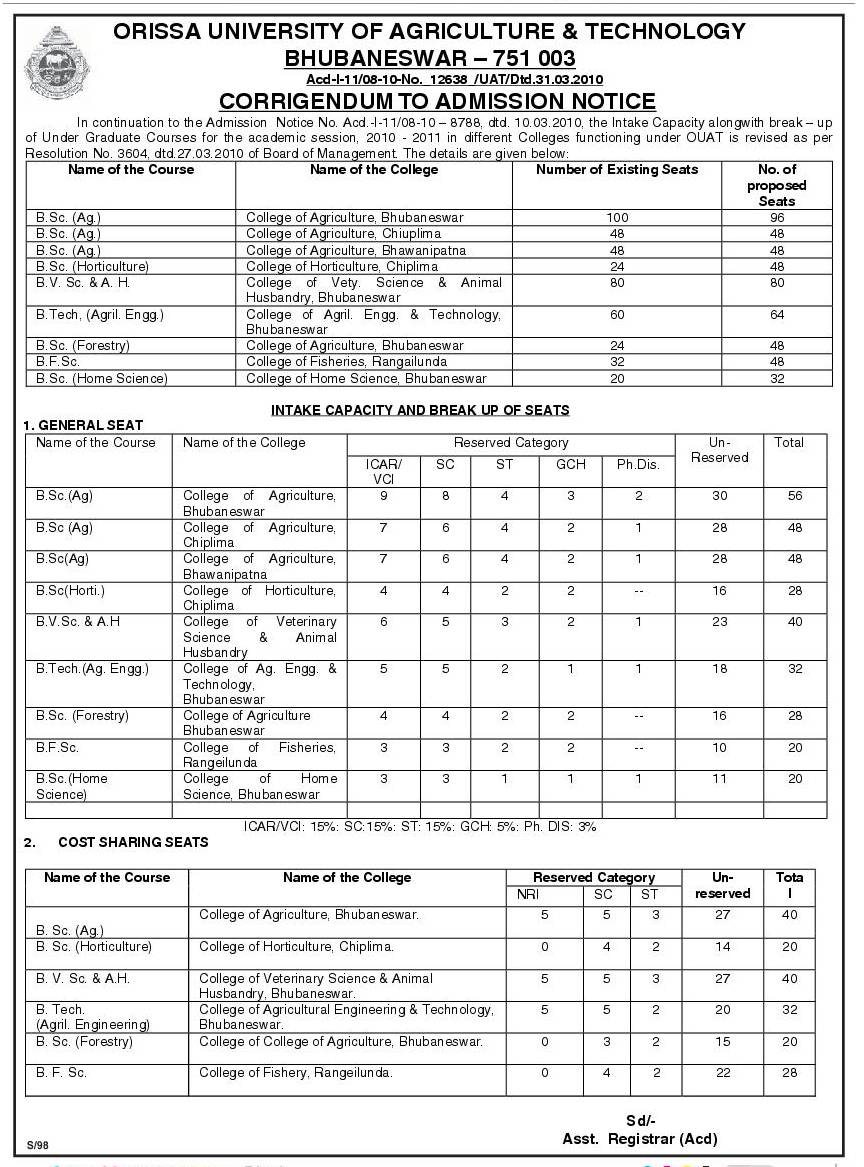
April 4th, 2010
Tathya.in reports that this time nice debates are going on in the Odisha assembly.Following are some Samaja reports on debates relevant to education.
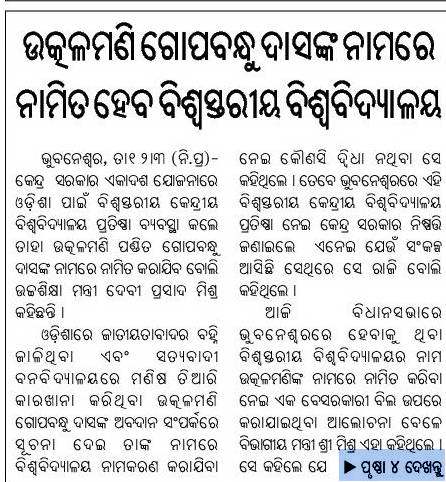
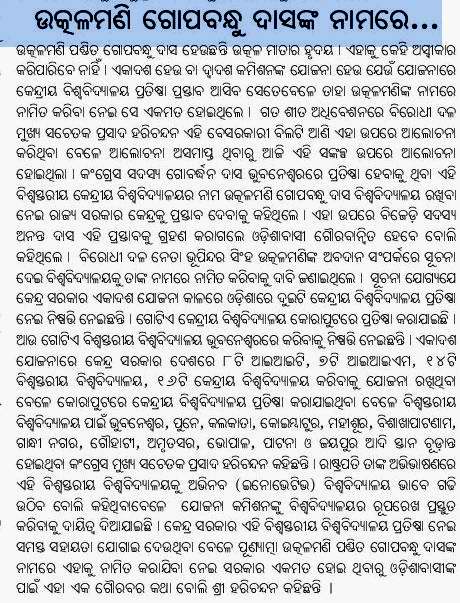
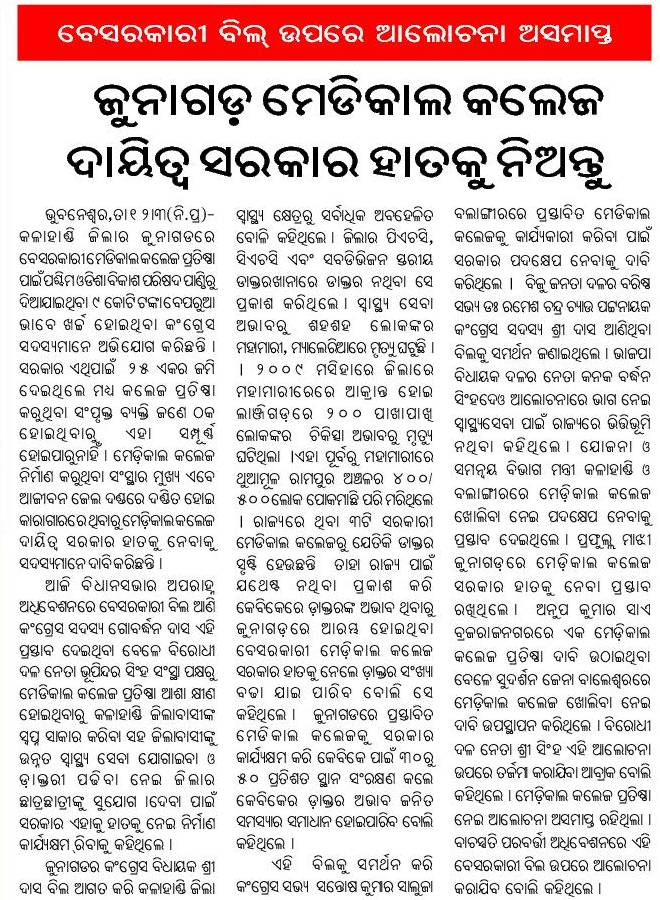
March 14th, 2010
Previous Posts







